Introducing the SST Video Archive
Bringing the practitioners’ voice to the fore, acknowledging their own understanding of what they do, and giving value to their own lived experience are important ways to ensure that the research is respectful of the grassroots scenes within which the knowledge is originated. As part of the non-extractive research ethos, filming research interviews opens up further possibilities in terms of the giving back, the dissemination and the reach out of the SST archive. We are very pleased to welcome to the SST blog Siufan Adey whose experience and commitment has allowed the SST video archive to come to the light with a first bunch of excerpts from the Huddersfield study.
Click here to access the SST video archive.
By Siufan Adey
I was initially drawn to the Sonic Street Technologies (SST) project because of my interest in the spaces, art and ephemera that marginalised communities produce as forms of resistance. These creations are especially important because they challenge the dominant narratives promoted by state and corporate entities that often (re)produce oppression. My desire to become SST’s Video Archivist, however, stemmed solely from my love for music. As a frequent participant in the sonic spaces across London that owe their existence to sound system culture – and as someone who has found healing and community in such spaces – I wanted to help build the archive as a way to give back. This motivation aligns with SST’s foundational principles of respect and recognition, and has guided my approach to handling and presenting the material in the archive.
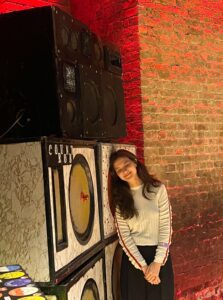
Siufan having a moment with Mighty Ruler sound system. Photo by Eli Saunders.
Archive References
Through previous research projects, I’ve encountered a diverse range of archives, including those established by local councils, institutions such as the National Archives, community archives like the George Padmore Institute, and radical repositories like 56a Infoshop. In most cases, the materials that constitute these archives are primarily written, including but not limited to reports, newspaper clippings, letters, meeting notes, zines, pamphlets, maps and architectural plans and sections.
However, due to the DIY nature of sound system culture, its tendency to operate outside of traditional institutional spaces and the limited production of written materials, archives like the ones mentioned above are ill-equipped to hold all that makes sound system culture unique. These factors have collectively contributed to the SST project’s conclusion that video recordings of oral histories – as opposed to a dependence on written testimony and photography – offer the most effective means of documenting this vibrant and dynamic culture.
To make a virtue of this material, as my colleague Aadita Chaudhury has noted in her blog post Music Scenes and the SST Archive, the SST project learns from existing initiatives like Oral History Society and Decolonising the Archive, and presents the archive online in the form of a YouTube channel.
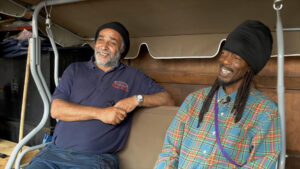
Riddim Master (left) and Dee Bo General (right) reminisce on the music they grew up with. Still from video captured by Zoe Opal East.
The Video Material
When I began in my role as Video Archivist, I was presented with hours upon hours of material in the form of filmed interviews with sound system operators, venue owners, engineers, punters, family members and the wider community – and this was just the Huddersfield case study! These interviews were originally captured by Mandeep Samra and Gopal Dutta in 2021. It was my responsibility as the Video Archivist to ensure that the deep technical knowledge, life experiences and cherished memories shared within these interviews were made available to a broader audience.
As I progressed through the material, I experienced a growing sense of appreciation for the privilege of having the opportunity to witness some beautiful moments. These instances served to highlight the inherent superiority of video records over their written counterparts.
An example of such a moment occurred during a conversation with Dee Bo General and Riddim Master. As they reminisced about the music they had listened to during their formative years, their shared friendship and experience of growing up in the same town and time period facilitated a cascade of recollections. As they sparked off each other and delved deeper into their memories, they recalled details such as the brand of their parents’ radiograms on which they performed some of their first technological experiments, as well as the music that contributed to the development of their social and political consciousness, and personal identities. This level of insight might not have been attainable through a written record or a single-person interview.
Another magical moment arose during an interview with Stephen “Papa Burky” Burke, the operator of the renowned Earth Rocker sound system. Earth Rocker was one of the most celebrated sound systems in the north of England during its heyday in the 1980s. While Papa Burky is unquestionably masterful in running the sound, his expertise appears to be more embodied, which was difficult to convey verbally and generated a more fragmented conversation. However, at a particular juncture in Papa Burky’s interview, Gopal Dutta and Mandeep Samra broached the subject of kill switches and their impact on the crowd’s energy during a dance. Papa Burky lights up as he is transported back in time. His words flow freely, recounting how these switches would rouse the audience and cut out a section of the sound system in order to bring it back in at a critical point in the music. This, Papa Burky tells us, made the crowd “go wild!”. Such moments, recorded in high resolution video, capture an essence that cannot be conveyed in written transcripts. It is an essence that I would perhaps describe as the soul of the subject matter.
Video footage can also capture and convey a range of additional, intangible information that may not be possible via other recording formats. This includes accents, which can offer insight into migration patterns and class distinctions. Additionally, facial expressions and body language can help to convey personality, while the environment in which an interview takes place might reveal further subtle details about the interviewee. Most importantly, this method places the people who shape sound system culture at the heart of the SST archive.
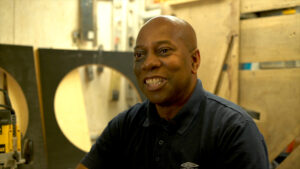
Stephen Burke aka Papa Burky recalls operating Earth Rocker sound system. Still from video captured by Zoe Opal East.
Why YouTube?
The decision to establish the archive as a YouTube channel has both its merits and its tensions, which required careful consideration when selecting clips for publication. While a YouTube archive provides greater accessibility compared to archives such as the National Archives in Kew, which require a visitation appointment and an access card, it was important to avoid the “contentification” of the footage – that is, the prioritisation of conventionally “watchable” interview segments to accumulate plays, likes, shares and subscribers. Not only is this approach problematic and extractive as it considers the interviewees’ personal memories and stories as mere “content”, but it also risks creating a less inclusive archive. While it is important to share the archive widely, giving preference to the viewer’s experience over the interviewees’ inclusion could exclude individuals who express themselves in a more roundabout way due to nervousness, speech impediments, trauma, neurodivergence or ageing.
At the same time, including all of the footage in the archive, unedited, would do an equal disservice to both the interviewees and the viewers. Lengthy extracts effectively bury significant stories and essential knowledge, while excluding viewers who don’t have the time or capacity to sift through an entire interview.
From my previous experience with archives, I’ve learned that archiving is not objective. Indeed, in his 1999 essay The Ordinariness of the Archive, Thomas Osbourne notes that the archivist is not an unassuming, passive figure but an agent of power. Archivists make choices about who and what to include, revealing who and what they consider valuable enough to preserve for future generations. As such, the SST YouTube channel will not only serve as an archive of sound system culture but will also document the values and priorities of the SST project.
When putting together the SST YouTube channel, it was necessary to balance these tensions and to use my power as the archivist to positive ends. I refer to this as “making the material sing” through curation and have established three basic principles to guide the sort of material included in the archive, which I’ve outlined below.
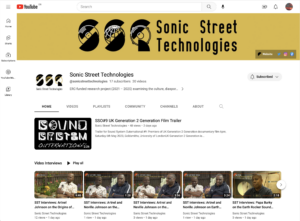
Screenshot of the SST archive on YouTube
Three Principles for an Inclusive SST Archive
- The archive must contain at least one clip from each sound system operator, scene pioneer or cultural producer, describing their creation in their own words. Including these accounts in the archive not only shows these individuals respect and recognition for their contribution but also improves the accuracy of the archive, making it a primary source of information for future researchers as well.
- The archive must ensure a balanced representation of speakers. Sound system culture has evolved over the course of several decades to become a diverse and multifaceted movement shaped by people from various backgrounds, cultures and experiences. Publishing a range of interviewees in the archive is essential to avoid stereotypes and generalisations. However, given the historical erasure of Black people’s contributions to culture, particularly in the UK, it is important to prioritise the inclusion of these groups in the archive. By doing so, the archive endeavours to counteract the historical neglect of these important contributions.
- The archive must strike a balance in information. In the case of the Huddersfield documentary, interviewees were asked similar questions, which resulted in some overlapping responses. To ensure a well-rounded archive that reflects the depth and width of sound system culture, it is necessary to give space to different answers over duplicating material.
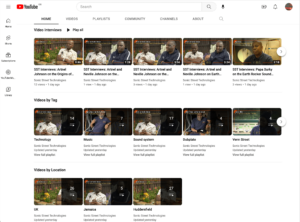
The three sections that currently make up the archive’s homepage.
How to Use the Archive
The archive consolidates video extracts and short films commissioned as part of the SST project into a single location. The YouTube homepage categorises these materials into three sections: Video Interviews, Videos by Tag, and Videos by Location.
The first section, Video Interviews, features all the clips extracted from lengthier interviews. A full transcript of the original interview is available upon request via email at info@sonic-street-technologies.com.
The Videos by Tag section on the homepage comprises thematic playlists, each containing multiple videos that explore a particular theme such as “technology,” “music,” or “identity.” Selecting a playlist enables users to discover videos from other case studies across the SST project that also touch on the same theme.
In the Videos by Location section, users can search for interviews and short films from a particular part of the world. Currently, I have only managed to process material from Huddersfield, UK, but this section will expand as more videos are analysed.
A fourth section, Short Film Commissions, will be added soon. This section will showcase films made by local filmmakers who are involved in SST scenes across the globe. These films were commissioned by the SST project to acknowledge and respect the networks that surround and sustain these scenes, as well as the situated knowledge embedded within them.
The YouTube archive will be regularly updated with new videos and films as the SST project advances.
–
Siufan Adey is a researcher and video-maker currently studying MA Research Architecture at Goldsmiths. She is also co-founder of Afterparti, a collective that produces a zine and event series to platform underrepresented voices in the built environment.
